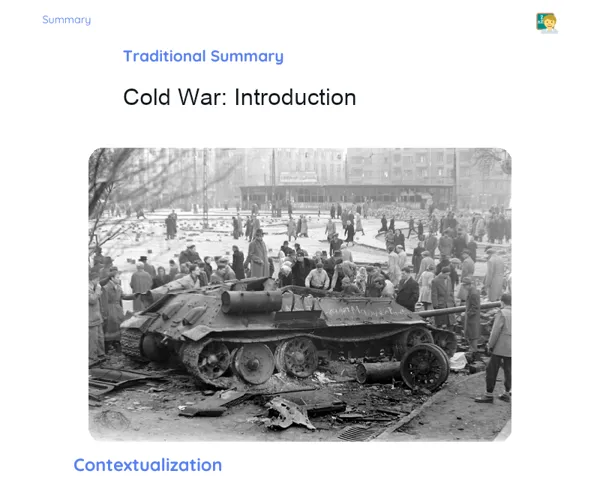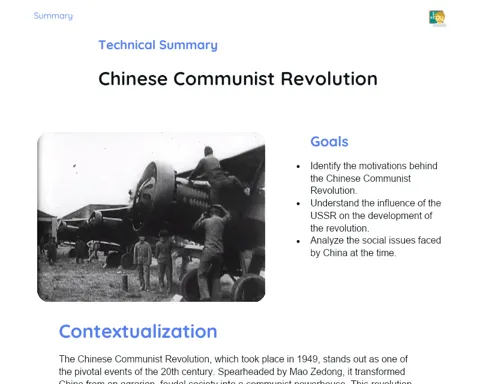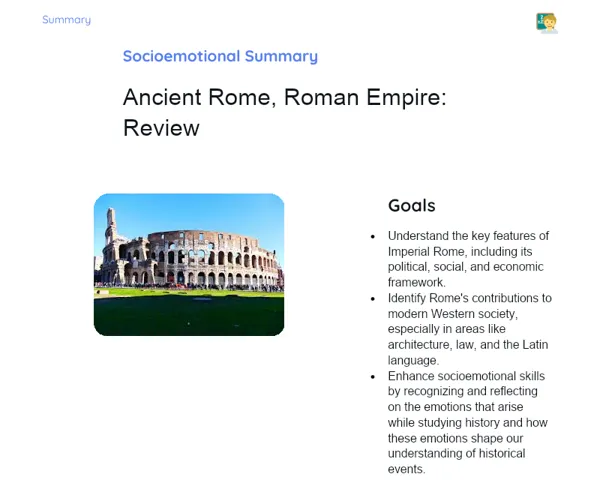Summary Tradisional | Ancient Rome: Roman Empire
Contextualization
The Roman Empire was among the most influential and enduring civilizations in world history. Established in the 8th century BC, it began as a humble city-state and, through a blend of military conquests, shrewd diplomacy, and effective governance, grew into a massive empire that covered much of Europe, North Africa, and the Middle East. This historical era is characterized by Rome's evolution from a republic to an empire, significantly altering its political and social fabric.
The legacy of the Roman Empire is not just defined by its size but also by its enduring contributions to Western civilization. The Pax Romana, a period lasting about 200 years of relative peace and stability, facilitated economic prosperity and cultural advancement, alongside major developments in fields such as architecture, engineering, law, and urban planning. Many of these Roman innovations and practices remain relevant today, influencing our urban infrastructure and legal systems.
To Remember!
Foundation of Rome
The founding of Rome is steeped in myths and tales, with the most famous being that of Romulus and Remus. According to the legend, these twin brothers, the sons of Mars, the god of war, and a vestal priestess, were left to float in a basket on the Tiber River, where they were nursed by a she-wolf. They were eventually rescued and raised by a shepherd. When they grew up, Romulus and Remus aimed to establish a new city, but a disagreement over the site led Romulus to kill Remus and lay the foundations of Rome in 753 BC.
Rome began as a tiny city-state on the Italian peninsula. Its advantageous location by the Tiber River encouraged trade and economic development. The governance of Rome evolved over time, starting with a monarchy, followed by a republic, and ultimately an empire. Each stage brought significant changes that set the stage for further expansion.
The change from a city-state to an empire was defined by military conquests, strategic alliances, and effective governance. The Roman Republic, created in 509 BC, introduced a system of elected councils and magistrates, which allowed for improved administration and greater involvement of citizens in governance. This period was crucial for establishing the institutions that later supported the Roman Empire.
-
Legend of Romulus and Remus
-
Foundation of Rome in 753 BC
-
Transition from city-state to republic and empire
Expansion of the Roman Empire
The expansion of the Roman Empire was a slow and steady journey that unfolded over centuries. Initially, Rome extended its reach within the Italian peninsula, conquering neighbouring cities and subduing local tribes. A landmark moment was the victory in the Punic Wars against Carthage (264-146 BC), which enabled Rome to dominate the western Mediterranean and set the stage for further conquests.
The highly disciplined and trained Roman legions played a crucial role in military success. Under influential commanders like Julius Caesar, the legions captured vast areas, including Gaul, Britannia, and parts of the Middle East and North Africa. This territorial expansion brought wealth and resources to Rome but also introduced new administrative and defensive challenges.
The empire's growth was multifaceted—not only military, but also cultural and economic. Rome integrated elements of the conquered cultures, fostering a sense of unity that fortified the empire’s stability. The extensive network of Roman roads streamlined trade and communication, knitting together the different regions under Roman rule. However, this expansion also led to social and political rifts, factors which contributed to the eventual decline of the empire.
-
Initial conquests in the Italian peninsula
-
Victory in the Punic Wars
-
Importance of the Roman legions
Politics and Governance
The governance of Rome saw significant evolution over the centuries. During the Republic, power was shared among various bodies like the Senate, Assemblies, and Magistrates. The Senate, primarily made up of aristocrats, wielded considerable influence over political and military matters. The Consuls, elected annually, acted as the chief executives accountable for administration and military operations.
As Rome transitioned to an Empire, power became concentrated in the hands of the Emperor. The first emperor, Augustus, set up an authoritarian governance structure while retaining some republican institutions to maintain the façade of continuity. The Pax Romana, or Roman Peace, initiated by Augustus, constituted about 200 years of relative tranquility and stability, which spurred economic and cultural growth.
The Roman system of governance left a lasting imprint on the political and administrative structures of later Western societies. Roman law, with its codification and legal principles, became a foundation for many contemporary legal systems. Additionally, the concept of a centralized government with effective administration served as a blueprint for subsequent states and empires.
-
Structure of the Senate and Consuls during the Republic
-
Centralization of power in the figure of the Emperor
-
Importance of the Pax Romana
Decline and Fall of the Roman Empire
The decline and fall of the Western Roman Empire is a well-studied chapter of history, marked by a host of internal and external factors that contributed to this complex process. Internally, the empire grappled with issues like corruption, economic downturns, and political instability. An overly centralized administration led to inefficiencies, while power struggles undermined the empire's cohesiveness.
Externally, the empire faced relentless pressure from barbarian groups such as the Goths, Vandals, and Huns. Their invasions and raids strained Roman defenses. The Battle of Adrianople in 378 AD, where the Goths defeated the Roman forces, was a pivotal moment that highlighted the empire's vulnerabilities.
The formal division of the empire into Western and Eastern sections in 395 AD also played a role in its decline. While the Eastern Roman Empire, known as the Byzantine Empire, managed to thrive for another thousand years, the Western Roman Empire deteriorated rapidly. The ultimate collapse occurred in 476 AD when the last Roman emperor of the West, Romulus Augustulus, was overthrown by Odoacer, a Germanic chief.
-
Internal factors: corruption, economic crises, political instability
-
External factors: barbarian invasions
-
Division of the empire and fall of the Western Roman Empire in 476 AD
Key Terms
-
Roman Empire: A civilization that dominated much of Europe, North Africa, and the Middle East between the 8th century BC and 476 AD.
-
Romulus and Remus: Legendary figures associated with the foundation of Rome.
-
Pax Romana: A period of around 200 years of peace and stability in the Roman Empire.
-
Roman Legions: Highly disciplined military units essential to Roman expansion.
-
Roman Senate: A political assembly comprised of aristocrats with significant influence during the Republic.
-
Emperor: The autocratic figure that led the Roman Empire post-Republic.
-
Roman Law: The legal framework established in Rome, which influenced many modern legal systems.
-
Barbarian Invasions: Assaults by tribes like Goths, Vandals, and Huns that contributed to the Western Roman Empire's downfall.
-
Division of the Empire: The partitioning of the Roman Empire into Western and Eastern halves in 395 AD.
-
Fall of the Roman Empire: Marked the end of the Western Roman Empire in 476 AD.
Important Conclusions
The Roman Empire stands as one of the most impactful civilizations in history, with its foundation, expansion, and eventual fall profoundly shaping the trajectory of Western history. Its evolution from a small city-state to a sprawling empire was characterized by military success, governance innovations, and the incorporation of diverse cultures. These elements not only helped Rome enlarge its territory but also enabled it to establish a rich legacy in law, engineering, and culture.
The Pax Romana was a critical period that ushered in stability and prosperity, fostering economic and cultural growth. The concentration of power in the Emperor, alongside the preservation of republican institutions, played a pivotal role in maintaining this peace. However, internal strife and external threats ultimately led to challenges that resulted in the empire's downfall. Corruption, economic troubles, and invasions eroded Rome’s strength, leading to its division and collapse in 476 AD.
The enduring legacy of the Roman Empire is evident across various facets of modern society. From urban infrastructure to legal frameworks and cultural influences, the contributions of Rome continue to shape our lives today. Understanding Rome’s history is crucial for appreciating the foundations of Western civilization and the developments that have shaped our current world.
Study Tips
-
Review the key points that were discussed in class and take comprehensive notes on each topic to reinforce knowledge and ease future revision.
-
Explore documentaries and literature on the Roman Empire to supplement classroom learning. Visual and textual materials can provide different viewpoints and enhance understanding.
-
Participate in study groups or online discussions to share and exchange insights on the topic. Engaging with peers can lead to new perspectives and help clarify any uncertainties.



